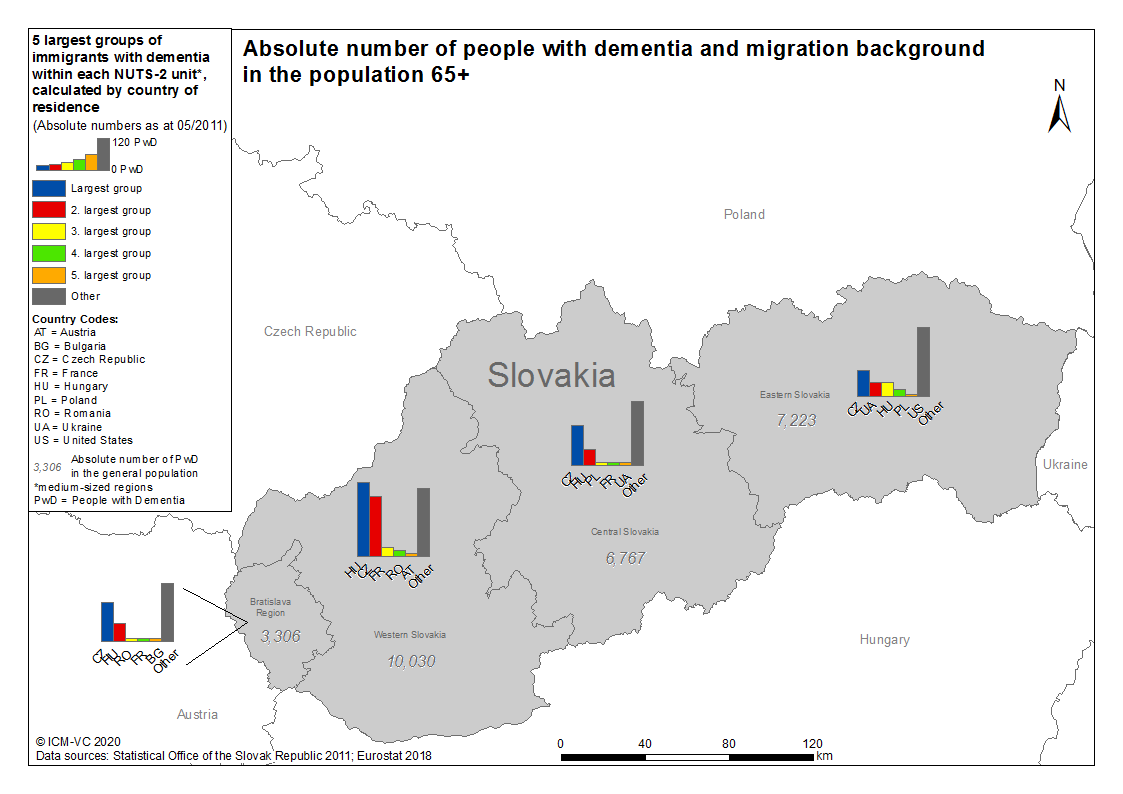EU-Atlas: Dementia & Migration
| Largest group | 2. largest group | 3. largest group | 4. largest group | 5. largest group | |
| Absolute numbers | |||||
| PwMD per 100,000 inhabitants 65+ |
| Absolute numbers | PwMD per 100,000 inhabitants 65+ | |
| Largest group | ||
| 2. largest group | ||
| 3. largest group | ||
| 4. largest group | ||
| 5. largest group |
| Prevalence per 100,000 inhabitants 65+*, calculated by country of residence | |||
|---|---|---|---|
| high > PwMD |
minor > - PwMD |
||
| increased > - PwMD |
low ≤ PwMD | ||
| medium > - PwMD |
|||
| PwMD = People with a Migration background with Dementia *Bulgarien, Litauen, Malta, Polen in der Bevölkerung 60+ |
|||
| Absolute number of PwMD 65+ | |
| PwMD per 100,000 inhabitants 65+ |
Slovakia
In the last three centuries, Slovakia was a country of emigration1. Migratory waves were mainly influenced by the first and second world wars2. From 1950 to 1989, there were large migratory movements between the present-day Czech Republic and Slovakia. Slovakia experienced a net migration loss of 230,000 inhabitants. However, succeeding historical events contributed to a further increase in migration, including the collapse of the communist regime in the late 1980s; the foundation the Slovak Republic on January 1, 19933; and Slovakia's accession to the EU (2004) and the Schengen area (2007). Most migrants in 2013 came from the Czech Republic, followed by Hungary, Ukraine, Romania, and Poland4. Between 1990 and 2019, the migrant population (born abroad), and the proportion of migrants in the total population more than quadrupled (41,300 to 188,000; 0.8 to 3.4%)5. Currently, Slovakia is mainly a transit country for migrants from Eastern Europe6.
There are 38,200 people with a migration background aged 65 or older. Of those, approx. 1,500 are estimated to exhibit some form of dementia. Calculations show the most affected migrant groups presumably originate from the Czech Republic (approx. 600), Hungary (approx. 500), Ukraine (approx. 90), France (approx. 70) and Poland (approx. 60)7.
For Slovakia, no national dementia plan and national guidelines for dementia care were identified. According to a high-ranking representative of the Slovak healthcare system, a document on combating dementia (‘Slovakia Against Dementia’) is being prepared8.
References
- Letavajová S, Divinský B: Migration and Development in Slovakia. In. Edited by Kadysheva O, Taran P, Wickramasekara P, Gnes D, Pfohman S. Bratislava: Caritas Slocakia; 2019.
- Divinský B: Slovakia: An Acceleration of Challenges for Society. In., vol. 5. Bratislava; 2004.
- Drbohlav D: International Migration in the Czech Republic and Slovakia and the Outlook for East Central Europe. Czech Sociological Review 1994, 2(1):89-106.
- United Nations: Migration Profiles: Slovakia; 2013.
- International Organisation for Migration: International migrant stock as a percentage of the total population at mid-year 2019: Slovak Republic; 2019.
- Szczepanikova A: Czech Republic and Slovakia, migration 19th century to present; 2013.
- Statistical Office of the Slovak Republic: Census 2011. In. Bratislava: Statistical Office of the Slovak Republic 2011.
- University Hospital Bratislava: National treatment guidelines for dementia. In., E-Mail conversation edn; 2019.



![[Translate to Englisch:] Logo RBS [Translate to Englisch:] Logo RBS](/fileadmin/_processed_/9/7/csm_RBS_Logo_RGB_0e245a98a4.jpeg)